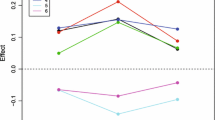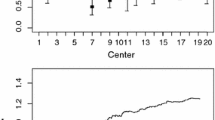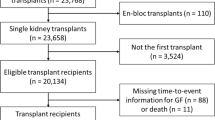Abstract
We consider variable selection in competing risks regression for multi-center data. Our research is motivated by deceased donor kidney transplants, from which recipients would experience graft failure, death with functioning graft (DWFG), or graft survival. The occurrence of DWFG precludes graft failure from happening and therefore is a competing risk. Data within a transplant center may be correlated due to a latent center effect, such as varying patient populations, surgical techniques, and patient management. The proportional subdistribution hazard (PSH) model has been frequently used in the regression analysis of competing risks data. Two of its extensions, the stratified and the marginal PSH models, can be applied to multi-center data to account for the center effect. In this paper, we propose penalization strategies for the two models, primarily to select important variables and estimate their effects whereas correlations within centers serve as a nuisance. Simulations demonstrate good performance and computational efficiency for the proposed methods. It is further assessed using an analysis of data from the United Network of Organ Sharing.
Similar content being viewed by others
References
Christian NJ, Ha ID, Jeong JH (2016) Hierarchical likelihood inference on clustered competing risks data. Stat Med 35(2):251–267
Evans RW, Manninen DL, Dong F (1991) The center effect in kidney transplantation. Transpl Proc 23(1 Pt 2):1315–1317
Fan J, Li R (2001) Variable selection via nonconcave penalized likelihood and its oracle properties. J Am Stat Assoc 96(456):1348–1360
Fan J, Li R (2002) Variable selection for cox proportional hazards model and frailty model. Ann Stat 30(1):74–99
Fan J, Lv J (2010) A selective overview of variable selection in high dimensional feature space. Stat Sin 20(1):101–148
Fibrinogen Studies (2009) C.: Measures to assess the prognostic ability of the stratified cox proportional hazards model. Stat Med 28(3):389–411
Fine JP, Gray RJ (1999) A proportional hazards model for the subdistribution of a competing risk. J Am Stat Assoc 94(446):496–509
Friedman J, Hastie T, Tibshirani R (2010) Regularization paths for generalized linear models via coordinate descent. J Stat Softw 33(1):1–22
Fu Z, Parikh CR, Zhou B (2016) Penalized variable selection in competing risks regression. Lifetime Data Anal 26:1–24
Glidden DV, Vittinghoff E (2004) Modelling clustered survival data from multicentre clinical trials. Stat Med 23(3):369–388
Ha ID, Christian NJ, Jeong JH, Park J, Lee Y (2014) Analysis of clustered competing risks data using subdistribution hazard models with multivariate frailties. Stat Methods Med Res. doi:10.1177/0962280214526193
Ha ID, Lee M, Oh S, Jeong JH, Sylvester R, Lee Y (2014) Variable selection in subdistribution hazard frailty models with competing risks data. Stat Med 33(26):4590–4604
Hastie T, Tibshirani R (1999) Generalized additive models. Chapman & Hall/CRC, Boca Raton
Hunter DR, Li RZ (2005) Variable selection using mm algorithms. Ann Stat 33(4):1617–1642
Katsahian S, Resche-Rigon M, Chevret S, Porcher R (2006) Analysing multicentre competing risks data with a mixed proportional hazards model for the subdistribution. Stat Med 25(24):4267–4278
Kim SJ, Schaubel DE, Jeffery JR, Fenton SS (2004) Centre-specific variation in renal transplant outcomes in Canada. Nephrol Dial Transpl 19(7):1856–1861
Kuk D, Varadhan R (2013) Model selection in competing risks regression. Stat Med 32(18):3077–3088
Lee Y, Nelder JA (2004) Conditional and marginal models: another view. Stat Sci 19(2):219–228
Lee EW, Wei LJ, Amato DA, Leurgans S (1992) Cox-type regression analysis for large numbers of small groups of correlated failure time observations. In: Survival analysis: state of the art. Springer, Berlin, p 237–247
Logan BR, Zhang MJ, Klein JP (2011) Marginal models for clustered time-to-event data with competing risks using pseudovalues. Biometrics 67(1):1–7
Morales JM, Campistol JM, Domnguez-Gil B, Andrs A, Esforzado N, Oppenheimer F, Castellano G, Fuertes A, Bruguera M, Praga M (2010) Long-term experience with kidney transplantation from hepatitis c-positive donors into hepatitis c-positive recipients. Am J Transpl 10(11):2453–2462
OPTN (2015) National data. http://optn.transplant.hrsa.gov/converge/latestData/rptData.asp. Accessed 1 Oct 2015
OPTN/SRTR (2011) 2011 annual report of the US organ procurement and transplantation network and the scientific registry of transplant recipients. Report, Department of Health and Human Services, Health Resources and Services Administration, Healthcare Systems Bureau, Division of Transplantation, Rockville; United Network for Organ Sharing, Richmond; University Renal Research and Education Association, Ann Arbor
O’Quigley J, Stare J (2002) Proportional hazards models with frailties and random effects. Stat Med 21(21):3219–3233
Port FK, Bragg-Gresham JL, Metzger RA, Dykstra DM, Gillespie BW, Young EW, Delmonico FL, Wynn JJ, Merion RM, Wolfe RA, Held PJ (2002) Donor characteristics associated with reduced graft survival: an approach to expanding the pool of kidney donors. Transplantation 74(9):1281–1286
Prentice RL, Cai JW (1992) Marginal and conditional models for the analysis of multivariate failure time data. Surviv Anal State Art 211:393–406
Rao PS, Schaubel DE, Guidinger MK, Andreoni KA, Wolfe RA, Merion RM, Port FK, Sung RS (2009) A comprehensive risk quantification score for deceased donor kidneys: the kidney donor risk index. Transplantation 88(2):231–236
Robins JM, Rotnitzky A (1992) Recovery of information and adjustment for dependent censoring using surrogate markers AIDS epidemiology. Springer, Berlin, pp 297–331
Roodnat JI, Mulder PG, Van Riemsdijk IC, Ijzermans JN, van Gelder T, Weimar W (2003) Ischemia times and donor serum creatinine in relation to renal graft failure. Transplantation 75(6):799–804
Royston P, Sauerbrei W (2004) A new measure of prognostic separation in survival data. Stat Med 23(5):723–748
Schoop R, Beyersmann J, Schumacher M, Binder H (2011) Quantifying the predictive accuracy of time-to-event models in the presence of competing risks. Biometrical J 53(1):88–112
Simon N, Friedman J, Hastie T, Tibshirani R (2011) Regularization paths for cox proportional hazards model via coordinate descent. J Stat Softw 39(5):1–13
Snoeijs MG, Winkens B, Heemskerk MB, Hoitsma AJ, Christiaans MH, Buurman WA, van Heurn LW (2010) Kidney transplantation from donors after cardiac death: a 25-year experience. Transplantation 90(10):1106–1112
Taylor RM, Ting A, Briggs JD (1985) Renal transplantation in the united kingdom and ireland-the centre effect. Lancet 1(8432):798–803
Therneau TM, Grambsch PM (2000) Modeling survival data: extending the Cox model. Springer Science & Business Media, Berlin
Tibshirani R (1996) Regression shrinkage and selection via the lasso. J R Stat Soc Ser B Methodol 58(1):267–288
Tibshirani R (1997) The lasso method for variable selection in the cox model. Stat Med 16(4):385–395
Wang H, Li R, Tsai CL (2007) Tuning parameter selectors for the smoothly clipped absolute deviation method. Biometrika 94(3):553–568
Weber M, Dindo D, Demartines N, Ambhl PM, Clavien PA (2002) Kidney transplantation from donors without a heartbeat. N Engl J Med 347(4):248–255
Wei LJ, Lin DY, Weissfeld L (1989) Regression-analysis of multivariate incomplete failure time data by modeling marginal distributions. J Am Stat Assoc 84(408):1065–1073
Wolbers M, Koller MT, Witteman JC, Steyerberg EW (2009) Prognostic models with competing risks: methods and application to coronary risk prediction. Epidemiology 20(4):555–561
Zhang CH (2010) Nearly unbiased variable selection under minimax concave penalty. Ann Stat 38(2):894–942
Zhang H, Lu W (2007) Adaptive lasso for cox’s proportional hazards model. Biometrika 94(3):691–703
Zhou B, Fine J, Latouche A, Labopin M (2012) Competing risks regression for clustered data. Biostatistics 13(3):371–383
Zhou B, Latouche A, Rocha V, Fine J (2011) Competing risks regression for stratified data. Biometrics 67(2):661–670
Zou H (2006) The adaptive lasso and its oracle properties. J Am Stat Assoc 101(476):1418–1429
Acknowledgments
Thank Dr. Schaubel for the invitation of submission. This publication was made possible by CTSA Grant Number UL1 TR000142 from the National Center for Advancing Translational Science (NCATS), a component of the National Institutes of Health (NIH). Its contents are solely the responsibility of the authors and do not necessarily represent the official view of NIH. This work was supported in part by Health Resources and Services Administration contract 234-2005-37011C. The content is the responsibility of the authors alone and does not necessarily reflect the views or policies of the Department of Health and Human Services, nor does mention of trade names, commercial products, or organizations imply endorsement by the US Government.
Author information
Authors and Affiliations
Corresponding author
Electronic supplementary material
Below is the link to the electronic supplementary material.
Rights and permissions
About this article
Cite this article
Fu, Z., Ma, S., Lin, H. et al. Penalized Variable Selection for Multi-center Competing Risks Data. Stat Biosci 9, 379–405 (2017). https://doi.org/10.1007/s12561-016-9181-9
Received:
Revised:
Accepted:
Published:
Issue Date:
DOI: https://doi.org/10.1007/s12561-016-9181-9




